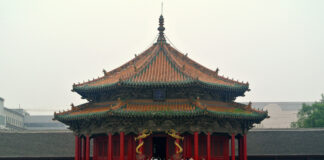
Byzantine gold coinage was immensely important in the political, social, and cultural life of the Near East and the Western Mediterranean during Late Antiquity and into the Middle Ages. Its significance can be judged from archaeological finds in Italy and Gaul as well as the Balkans, the Levant, and Northern Africa. Furthermore, from the 4th century onwards, Byzantine coins begin to appear along the Silk Roads, soon to be taken to countries in the Far East, including China.
Since the end of the 19th century, over one hundred Byzantine gold coins and coin imitations have been found in China. The findspots are mainly located in the northern areas, in a crescent extending from Xinjiang in the northwest to the province of Liaoning in the northeast. Chronologically, they mainly belong to a period from the late 6th century to the mid-8th century, i.e., from the late Northern Dynasties to the middle of the Tang Dynasty period, and they reflect the prosperity, exchange, and communication which once existed along the Silk Roads.
The international symposium on “Byzantine Gold Coins in the World of Late Antiquity,” held at the Institute for the History of Ancient Civilizations (IHAC) of Northeast Normal University (NENU), Changchun, China, 23-26 June 2017, aimed at delineating the political, economic, social, and cultural-religious conditions behind the flow of Byzantine gold coins not only into China but also within the broader Mediterranean region, into India, Central Asia, and Mongolia, as well as Southeast Asia. Even though some of the papers should be seen as very preliminary considerations on the respective subjects, all the investigations of specific coins in this volume contribute to the current development of building a more integrated and multifaceted picture of the world of Late Antiquity and the Early Middle Ages.
Contents
- Preface (VII–VIII)
- Program of the Conference (IX–XI)
- Papadopoulou, Pagona: The Gold of the Emperor: Imitations of Byzantine Gold Coins in the Mediterranean (5th–7th Centuries) (1–30)
- Jarrett, Jonathan: Coinage in the Western World at the End of the Roman Empire and After: Tradition, Imitation and Innovation (31–74)
- Günther, Sven: The Migration of Motifs: A Qualitative Approach to the Question of Connectivity in Late Antiquity (75–86)
- Wan, Xiang / Lin, Ying: A Preliminary Study of the Trade Patterns of the Silk Road during the Kushan Period (87–133)
- Darley, Rebecca: Byzantine Gold Coins and Peninsular India’s Late Antiquity (135–169)
- Kordosis, Stefanos: Some Remarks on the Terms “Fromo” and “Kesaro”
- in a Late 7th- to Early 8th-Century Bactrian Coin Legend (171–191)
- Li, Qiang: Trends and Dynamics in the Study of Byzantine Coins and their Imitations Unearthed in China: 2007–2017 (193–206)
- Guo, Yunyan: Classification of Byzantine Gold Coins and Imitations Found in China (207–240)
- Erdenebold, Lkhagvasuren: East-West Relations and Nomads: A Short Introduction to the Tomb of Shoroon Bumbagar, Bayannuur Soum, Mongolia (241–257)
- Guo, Yunyan: Features of Coins and Bracteates from the Shoroon Bumbagar Tomb in Mongolia (259–276)
- Borell, Brigitte: Coins from Western Lands Found in Southeast Asia (277–314)
Read the preface and view the contents at Academia.
Here you can find further information on the congress.



